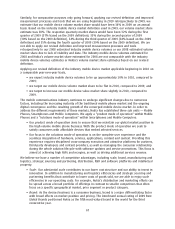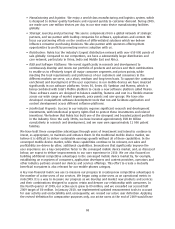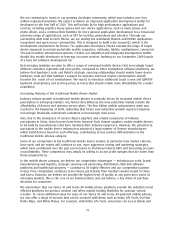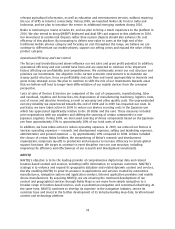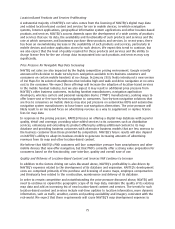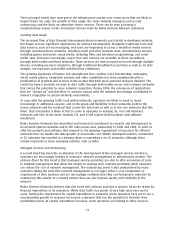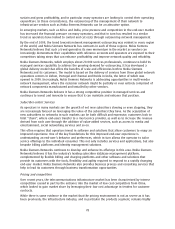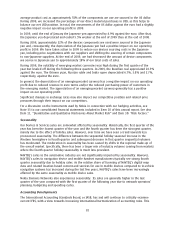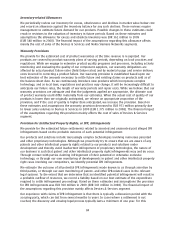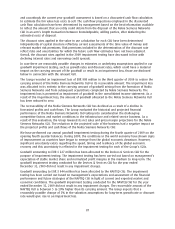Nokia 2009 Annual Report Download - page 79
Download and view the complete annual report
Please find page 79 of the 2009 Nokia annual report below. You can navigate through the pages in the report by either clicking on the pages listed below, or by using the keyword search tool below to find specific information within the annual report.Three principal trends have emerged in the infrastructure market over recent years that are likely to
impact future net sales: the growth of data usage; the move towards managed services and
outsourcing; and the focus on subscribercentric services. These can be seen as having a
complementary impact on the investment choices made by Nokia Siemens Network customers.
Growing Data Usage
The increased flow of data through telecommunications networks, particularly in developed markets,
has begun to have significant implications for network development. Alongside traditional voice and
data services, such as text messaging, endusers are beginning to access a wealth of media services
through communications networks, including email and other business data; entertainment services,
including games and music; visual media, including films and television programming; and social
media sites. Endusers increasingly expect that such services are available to them everywhere,
through both mobile and fixed networks. These services are now accessed and used through multiple
devices, including personal computers, through traditional broadband access lines as well as 3G data
dongles, settop boxes and mobile and fixed line telephones.
The growing popularity of feature rich smartphones that combine voice functionality, messaging,
email, media players, navigation systems and other capabilities has been complemented by a
proliferation of products and services in the market that both meet and feed enduser demand. The
result has been a dramatic increase in data traffic through both mobile access and transport networks
that carries the potential to cause network congestion. During 2009, the emergence of applications
that are “always on” and therefore in constant contact with the network increasingly contributed to
network congestion in certain networks and markets.
To cope with the growing traffic load within networks, operators are likely to need to invest
increasingly in additional capacity, and in the speed and flexibility in their networks, both in the
access networks and the backhaul that carries the data load as well as in the core networks that link
them. That investment is likely at first to come in upgrades to existing 3G, core and backhaul
networks and later in the move towards LTE, and it will require both hardware and software
investment.
Nokia Siemens Networks has intensified and focused its investment in research and development in
its network systems business and in the radio access area, particularly in 2008 and 2009, in order to
offer the products and software that respond to the growing requirement of operators for efficient
networks that can handle the data growth at reasonable cost. Within developed markets, investment
in 3G networks has resulted in a slowing down in expenditure on 2G networks, although these
remain important in many emerging markets, such as India.
Managed Services and Outsourcing
A second trend has been the acceleration in the development of the managed services market as
operators are increasingly looking to outsource network management to infrastructure vendors. The
primary driver for this trend is that managed services providers are able to offer economies of scale
in network management that allow the vendor to manage such contracts profitably while operators
can reduce the cost of network management. The outsourcing trend is also underpinned by many
operators taking the view that network management is no longer either a core competence or
requirement of their business and are increasingly confident that they can find greater expertise by
outsourcing this activity to a trusted partner that can also improve quality and reliability in the
network.
Nokia Siemens Networks believes that this trend will continue and that it could in future be driven by
financial imperatives of its customers. While data traffic has grown at very high rates over recent
years, fuelling the requirement for capital expenditure in networks, many operators have yet to see a
corresponding growth in revenues from users, a dynamic that has the potential to threaten their
profitability levels. As capital expenditure increases, some operators are looking to other areas to
77


